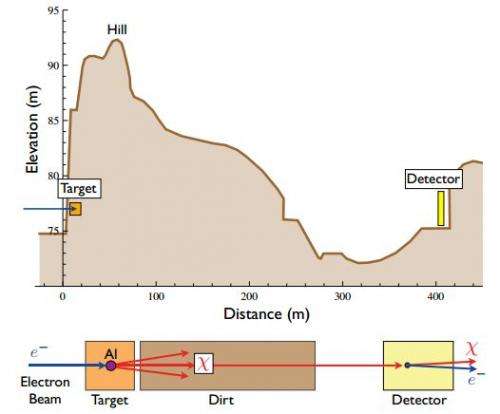October 27, 2014 report
Data from 'old' experiment appears to constrain the idea of dark photons as part of dark matter theory

(Phys.org) —A trio of physicists is suggesting in a paper they've published in Physical Review Letters, that results from an experiment run in the early 1980's places constraints on the idea of a dark photon in theories that attempt to explain the nature of dark matter. Brian Batell, Rouven Essig and Ze'ev Surujon note that a proposal already exists to construct a relatively inexpensive experiment that could be used to test the basic idea to either offer support or dispel the notion altogether.
Dark matter is, of course, the mysterious stuff that physicists believe possesses gravity that holds the universe together—without it, everything would fly apart. Unfortunately, no one has really been able to find observable evidence of its existence. Current theories suggest that dark matter is made of weakly interacting massive particles (WIMPs) which are only able to interact via the weak nuclear force. Physicists have set up facilities around the world with the aim of observing a WIMP pinging off atomic nuclei, but have thus far failed in their efforts.
Meanwhile, other ideas have begun to be tossed around by physicists, such as the concept of a particle called χ—if it exists, it would interact with others like it, the thinking goes, via a force akin to electromagnetism—that force, they believe could be conveyed by a photon analog, the dark photon. If such dark photons do exist, the theory continues, they would also likely interact with other "normal" matter, which should be observable. That's where data from an old experiment comes in.
From 1980 to 1982, researchers at SLAC National Accelerator Laboratory in Menlo Park were conducting "beam dump" experiments—ramming high energy electrons into an aluminum target and watching to see what could come through both the target and a sand-hill behind it. Batell, et al believe that high energy χs should have come through as well interacting (via dark photons) with at least some of the electrons. But the researchers conducting the beam dumps reported no recoiling electrons, which suggests that if there were dark photons present, there should be some limits regarding its properties.
The old experiments don't disprove the whole idea of χs or dark photons, but instead suggest that the theory that surrounds them needs to be more deeply thought out to better describe what their actual properties might be. To that end, other physicists have already proposed putting together a new, relatively inexpensive, beam dump experiment called BDX that would allow for 100 times as many events as the ones conducted in the 80's, hopefully offering a glimpse of observable proof of the existence of χs, dark photons and perhaps dark matter itself.
More information: Strong Constraints on Sub-GeV Dark Sectors from SLAC Beam Dump E137, Phys. Rev. Lett. 113, 171802 – Published 21 October 2014. dx.doi.org/10.1103/PhysRevLett.113.171802 . On Arxiv: arxiv.org/abs/1406.2698
ABSTRACT
We present new constraints on sub-GeV dark matter and dark photons from the electron beam-dump experiment E137 conducted at SLAC in 1980–1982. Dark matter interacting with electrons (e.g., via a dark photon) could have been produced in the electron-target collisions and scattered off electrons in the E137 detector, producing the striking, zero-background signature of a high-energy electromagnetic shower that points back to the beam dump. E137 probes new and significant ranges of parameter space and constrains the well-motivated possibility that dark photons that decay to light dark-sector particles can explain the ∼3.6σ discrepancy between the measured and standard model value of the muon anomalous magnetic moment. It also restricts the parameter space in which the relic density of dark matter in these models is obtained from thermal freeze-out. E137 also convincingly demonstrates that (cosmic) backgrounds can be controlled and thus serves as a powerful proof of principle for future beam-dump searches for sub-GeV dark-sector particles scattering off electrons in the detector.
Journal information: Physical Review Letters , arXiv
© 2014 Phys.org



















